How To Fix Knee Valgus (Valgus Collapse)

If you’re a bodybuilder, knee valgus is a term that you may not know yet but it’s one that you don’t want to hear. Here’s everything on this.
Knee valgus affects any lower body muscle movements in your routine and causes an immense amount of pain. It’s somewhat normal in young children, however, it remains prevalent in some of us into adulthood.
If you’re not training in a balanced way, you can inadvertently worsen knee valgus.
Valgus collapse isn’t an excuse to skip legs day. It’s an opportunity to understand why you must balance your mobility and strength in your legs while also ensuring you’re activating those typically “lazy” muscles like gluteus medius.
Correcting knee valgus is a balance of strengthening muscles that have been inactive and lengthening the muscles that have been dominating contraction in your exercise regime.
What’s Knee Valgus (Valgus Collapse)?
So, what does it look like? Have you ever seen someone squatting in the gym and cringed because their knees were caving inwards? This is a valgus collapse, commonly known as the ugly squat syndrome.
Knee Valgus and valgus collapse are exactly the same; another name for them is knocked knees or bowleg. It is where the adductor muscles are dominating resulting in the femur internally rotating.
It’s normal to have knocked knees as a child. In fact, over 20% of children at the age of 3 have.
However, by 7 years old, Boston hospital research stated that only 1% of children will have knee valgus which can be a sign of bone diseases. [1]
Knocked knees are where the knees touch, whereas the ankles do not. It is more prevalent in females due to the increased width of hips in women.
Why Does One Develop Knee Valgus?
In adults, knee Valgus can develop due to a number of factors such as:
- Obesity; [2]
- Insufficient calcium or Vitamin D;
- Arthritis; [3]
- Knee injuries;
- Bone disease or malformation.
How To Tell If You Have Knee Valgus?
The easiest way to see if you can knee valgus is to look in the mirror. Take a regular stance.
Most people’s knees are closer than their hips. However, if your ankles are wider than your knees, you may have knee valgus.
You may have valgus collapse if you notice yourself struggling to keep your knees in line with your toes during squats.
While checking with a health professional such as a GP or physiotherapist is best, some other ways to self-assess for knee valgus are:
- You have stiff joints.
- One leg is longer than the other.
- You walk with a limp.
- There is uneven wear in the soles of your shoes.
Why Should You Be Worried About Valgus Collapse As A Bodybuilder?
Bodybuilders should be worried about knee valgus as it will affect your ability to build muscle in your large compound movements such as leg press, squat, hip thrust, and deadlifts.
Your chance of injury is also greatly increased when performing these movements with valgus collapse.
This is because when you do a movement such as a leg press, the heavy load will be on your smaller knee joint rather than through your more stable hip joint.
While contracting the ugly squat syndrome should be enough cause for concern, you should be worried as it can lead to these issues:
- Arthritis;
- Meniscal tearing;
- Pain;
- Dislocation;
- ACL tears.
How To Fix Knee Valgus In Bodybuilders?
99% of the time, knee valgus is self-correcting in children. In adults? More work is needed.
Knee valgus is a result of your adductors dominating the contracting movement resulting in internal rotation of the femur. This means that your glute medius and abducting muscles are relaxed and inactive. [4]
The best way to fix knee valgus inside the gym is to complete some isolated abductor exercises to get your motor neurons firing in those areas before you work on the larger compound movements.
You’ll also need to stretch out your over-dominant adductors.
Isolated Exercises For Knee Valgus
The purpose of the following exercises is to increase strength and muscle activation in your gluteus medius, piriformis, and your abductor’s muscles to help externally rotate your femur.
These exercises are also a form of neuromuscular training helping your abductor muscles naturally fire during your training and outside of your training.
1. Banded Clam Shells
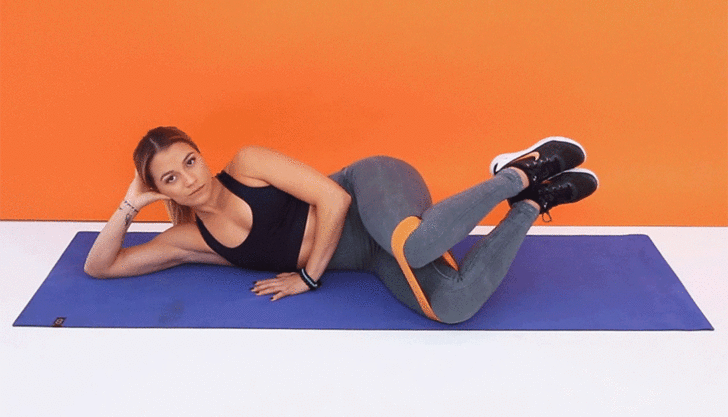
Banded clam shells isolate the muscles involved in external rotation such as your gluteus medius.
- Place a resistance band above your knees, on the lower part of your quadriceps.
- Lay on your side with your knees bent at a 45-degree angle.
- Keep your feet together, spine straight, and core engaged.
- Rotate your knee up, keeping your hips open.
- Hold for three seconds, return to the starting position.
2. Side Plank With Hip Lift
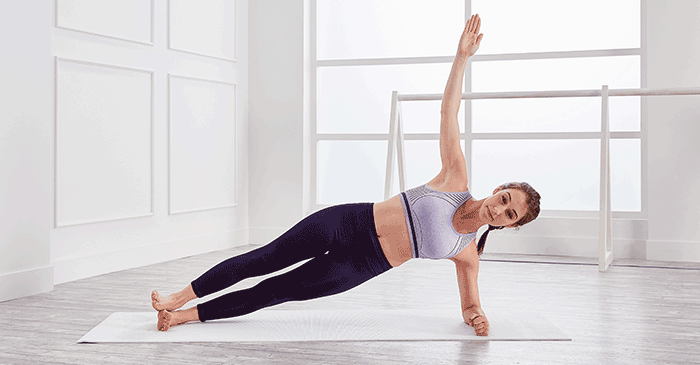
Side planks work your gluteus medius, gluteus minimus, transverse abdominis, adductors, and external and internal obliques.
While the isometric hold is also useful, the hip lifts will create neuro-pathways to encourage those muscles to fire outside of your training too.
- Lay on your side, stack your feet over each other.
- Place your hand under your shoulder and lift your hips.
- Ensuring your spine is in a straight line, dip your hips to the floor and lift up again.
- Repeat for 10 repetitions on each side with a 3-second hold at the top.
3. Hip Thrusts
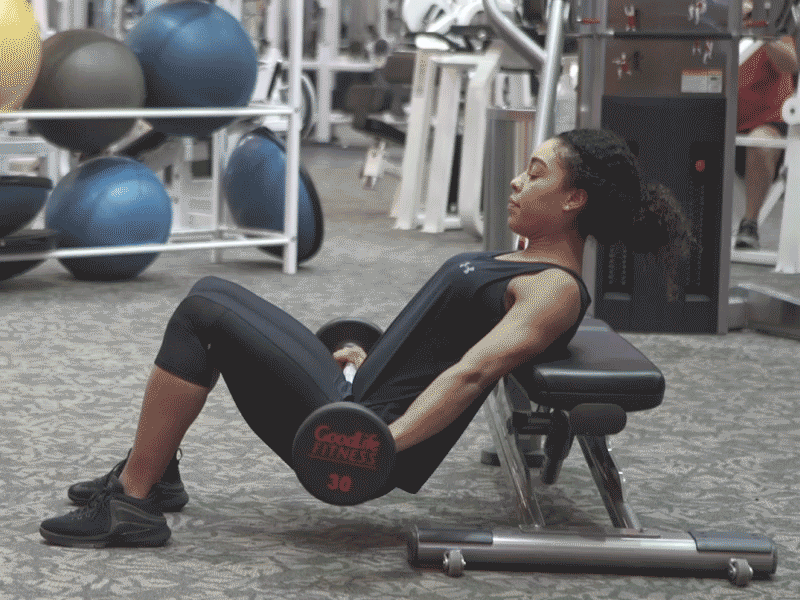
Hip thrusts are a compound movement that works the gluteus maximus, gluteus medius, quadriceps, and hamstrings.
To ensure the knees don’t cave inwards, a resistance band can be used above the knees on the lower quadriceps to maintain resistance.
- Place your upper back on a bench.
- Place a pad on your barbell to protect your hips.
- Roll the barbell into your hip joint, ensure it is evenly placed.
- Keep your feet planted hip-distance apart and drive hips upward.
- Hold for 1 second and lower.
- Repeat for 6-12 repetitions. Determine your specific rep ranges with your coach depending on your muscle growth goals.
4. Banded Squats
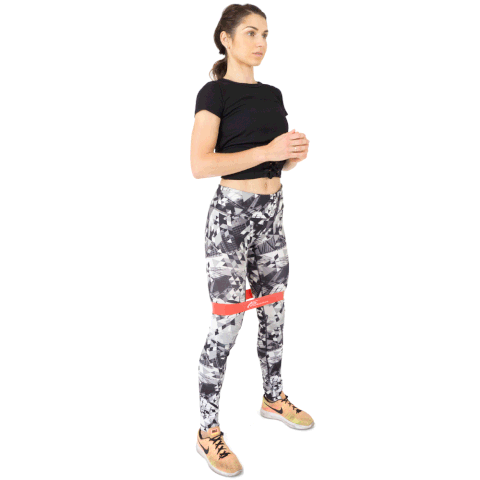
Banded squats activate the quadriceps and abductor muscles. They are the same as a regular squat, however, the band increases your mental awareness to stop your knees tracking inwards.
- Place a resistance band above your knees on your lower quadriceps.
- Keep your torso up while driving your hips as low as you can and keeping your body weight back.
- Throughout the movement keep your knees wide and pushing against the resistance band.
- When your hips are at a 90-degree angle or lower than your knees, keep your feet planted into the ground and drive your hips back up.
- Repeat 15 times.
Mobility And Stretching Exercises
The reason that the gluteus medius and abductors need to be strengthened is due to overactive adductors. They need to be stretched out to minimize the imbalance in the contrasting muscle groups.
Often, knee valgus can be a sign of stiff ankle joints. To avoid placing pressure on stiff joints, the femur internally rotates causing knee valgus.
1. Myofascial Release Of Adductors
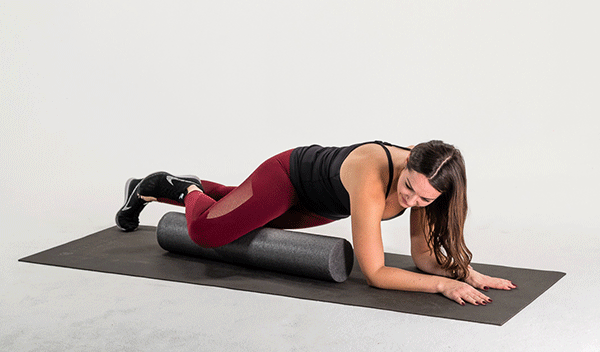
Using a roller to release the fascia in the adductors will help lengthen the muscle to stop them from trying to dominate many lower body movements.
- Lay on your stomach and place one leg out to the side.
- Place the roller on your inner thigh of the leg that’s to the side.
- Roll up and down the adductors focusing on areas that are tight.
- When you get to a tight area, rollover that area 10 times before finding more tight areas.
2. Static Adductor Stretching
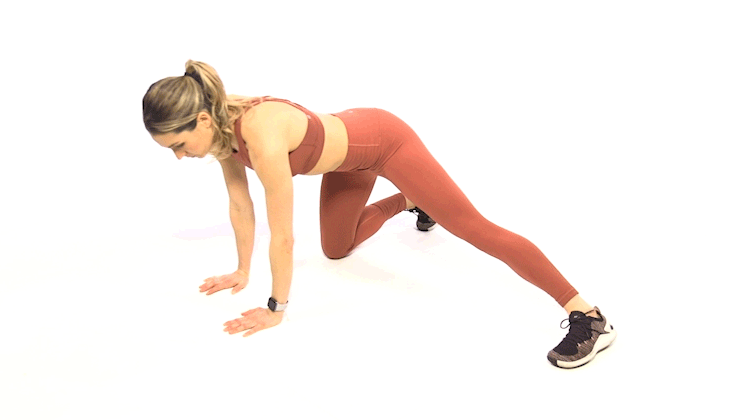
There are many stretches or yoga poses that will help in lengthening overworked adductors.
The classic adductor stretch is sitting with your legs wide and trying to get your stomach to the floor. But this can be difficult when you’re already inflexible in your adductors.
While any static adductor stretch is helpful, a kneeling adductor stretch is easy for anyone to do.
- From a kneeling position, place one leg straight to the side in line with the one that is still kneeling.
- Stretch your straight leg out as far as you can until you feel a stretch.
- Hold for 30 seconds and repeat on the other side.
3. Calf Stretch For Ankle Mobility
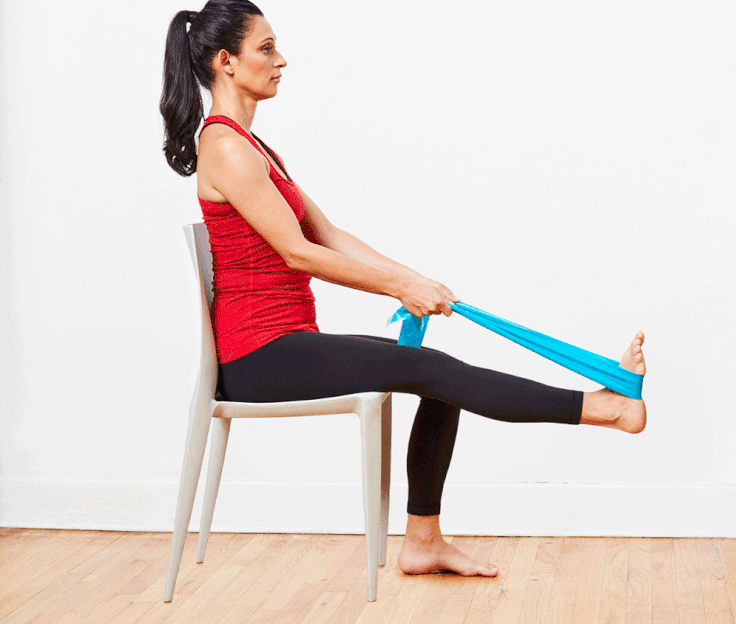
To test your ankle mobility is to kneel five inches away from a wall. Then, drive your body forward to see if your knee can touch the wall.
If they can, that’s great. If not, then try releasing your calf muscles to increase your ankle mobility.
- While seated, use a resistance band or a towel to wrap around the ball of your foot.
- Straighten your leg and pull on the band. As you gain more flexibility your foot should lift off the floor while your calf is grounded.
- Hold for 30 seconds, repeat on the other leg.
Techniques
1. Orthodics
Often people with knee valgus have one leg longer than the other or an uneven stance. This results in their shoes wearing down in an uneven way.
Outside of your training, investing in orthopedic soles will help in minimizing knee valgus. They will design soles for your specific problem based on where you’re wearing your shoes down the most to support your training.
2. Osteotomy
If you’ve tried the training and stretching exercises and there’s no change, you could have bone disease or malformity. I recommend asking for an x-ray from your general practitioner.
In an osteotomy, they will cut the tibia or the femur to release the pressure from the knee joint. This is a successful surgical method in knee collapse cases less than 10 degrees unaligned.
3. Total Knee Replacement
While an osteotomy is proven to help with knee deformities 10 degrees or less. If your deformity is larger than 10 degrees, you may need a total knee replacement [5].
This is not ideal for bodybuilding because of the long-lasting recovery time. However, it is an option for a small number of severe cases.
When it comes to knee valgus, prevention at the earliest opportunity is the best way to combat it worsening.
To maintain sustainable muscle building, both mobility and strengthening must be maintained in contrasting muscle groups. The same goes for preventing postural and alignment abnormalities like vagus collapse.